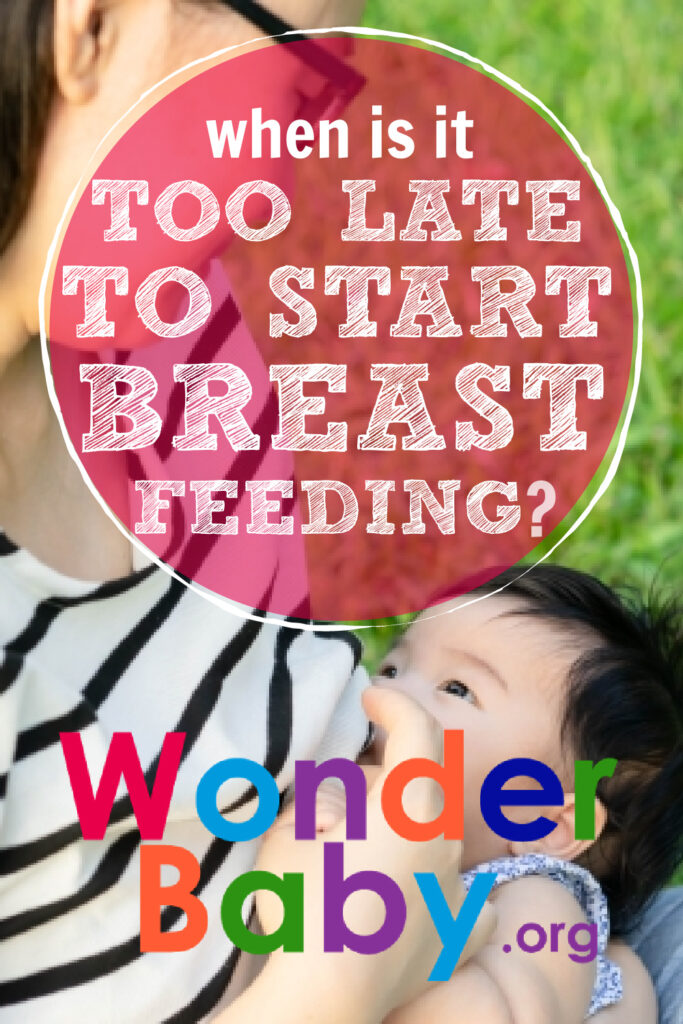When Is It Too Late to Start Breastfeeding?

This post may contain affiliate links; please see our terms of use for details.
- Breastfeeding is the natural way to feed your baby and offers the best start in life.
- You can restart your breastfeeding journey after a break using a process called relactation.
- Or perhaps you plan to adopt? Even if you’ve never been pregnant yourself, you can use induced lactation to produce breast milk.
- Both options take effort, commitment, and patience, but neither has time limits.
- When is it too late to start breastfeeding? Never.
Breast milk is uniquely designed to meet the nutritional needs of your baby. Once established, breastfeeding is super convenient, easy, and enjoyable.
Breastfeeding provides many health and emotional benefits for you and your baby, often lasting years into the future. Both the World Health Organization and the American Academy of Pediatrics recommend breastfeeding for the first two years of your child’s life and beyond.
Yet breastfeeding doesn’t have to begin at birth.
Is It Ever Too Late to Start Breastfeeding?
The short answer to this question is no; it’s never too late to start breastfeeding.
As mammals, humans are designed to provide milk for their babies and breast milk is the perfect source of nutrition for your little one.
Just because breastfeeding is natural, doesn’t mean it’s always easy. We know there are many reasons breastfeeding may not have been established at birth or may have been interrupted.
Maybe you weren’t aware of the benefits of breastfeeding, had no support, or were separated from your baby for medical or economic reasons. Perhaps you are welcoming a child into your family through adoption or surrogacy.
Whatever your personal circumstances, breastfeeding may be a viable option for you. Factors that can help make this process easier and faster include:
- having given birth or been pregnant before
- previous breastfeeding experience
- a baby that has nursed before
- professional and family support
- a good understanding of what’s involved
- being kind to yourself, and
- plenty of patience

Can You Start Again if You Stop Breastfeeding?
Absolutely. Studies have shown successful relactation rates can be as high as 98% with babies under four months old.
No matter the age of your baby, or however long ago you breastfed, your body will remember. The more times you’ve been pregnant, the more babies you’ve fed, and the longer you’ve spent feeding, the stronger those milk-making memories will be.
Even if you only breastfed once, or were concerned about low milk supply, there is a very good chance you will be able to begin breastfeeding again. Successful relactation relies on two factors that work in tandem – making breast milk and getting your baby to feed.
Luckily breastfeeding comes naturally to babies, and even when there’s little or no breast milk, they’ll often happily nurse for comfort. Once your body recognizes the demand, breast milk production increases, leading your baby to feed more often. A positive cycle of supply and demand is created.
Newborn and younger babies can feed as often as eight to twelve times a day. Your milk supply is likely to return quicker if you’re able to replicate this pattern through regular breast stimulation. Offer your baby the chance to feed when you can, and complement this with breast massage and expressing milk.
14 Tips for Successful Relactation
- Spend as much time with your baby as possible, especially skin-to-skin. Sleep close by, and consider baby-wearing and bathing with your baby.
- Bring your baby to the breast regularly, as often as every hour in the beginning. If your baby’s reluctant to latch on, try to start breastfeeding when they’re half asleep.
- Let your baby lead and latch on when they’re ready. Lay baby skin-to-skin, tummy down on your chest, expressing breast milk onto your nipple.
- Look out for hunger cues so you can offer a feed before your baby gets too upset. Cues can include:
- moving head side to side as if seeking the breast
- turning their head when you touch their face
- putting hands in or near their mouth
- smacking or licking lips
- flexing and wriggling arms and legs
- sucking motion or noises
- Take advantage of the night when prolactin is highest. Feed or express at night and in the morning to boost milk supply.
- Add in a power hour and mimic cluster feeding. Pump for 20 minutes, rest for 10, then alternate 10 minutes of pumping and resting to 60 minutes.
- Try an electric double breast pump to get more milk flowing. A total time-saver.
- Use breast compression. Squeezing the breast gently while your baby feeds will help stimulate milk production.
- Have a hand pump available for quick expressing. Or you can manually express. Don’t despair if pumping’s too tough, your baby’s the best pump of all.
- Offer both breasts at each feed and give your body the message: Make more milk.
- Take a warm bath or shower before feeding or expressing. Warmth can increase milk flow.
- BREAST SHIELD FOR SORE OR CRACKED NIPPLES – The breast shells are designed to be placed in your bra. Compared with soothies gel pads, these nursing shells protect nipples from friction and help with relieving engorgement
- COLLECT EVERY DROP OF BREASTMILK – Breast milk collector storage. Compared with nursing pads, they help you collect precious breast milk leaks and relieve the discomfort and pressure of unexpressed milk. Never worry about getting shirts wet while breastfeeding with milk-saver
- SOFT AND SAFE SILICONE MATERIAL(BPA-free) – Soft and flexible silicone material reduces the pressure of breast and fits your body more snugly. No longer suffer from hard plastic. Made of 100% food-grade material, ensuring the breastmilk quality
- UNIQUE DESIGN OF AIR VENT – The design of Air vent allows for airflow so the nipples can heal and be ventilated. It’s also convenient for transferring milk to bottles
- Catch all the milk you can from both breasts. Pump when your baby feeds, and use breast shells to collect leaking milk.
- Take good care of yourself and keep your fluid intake high. Make sure you eat a healthy diet and get plenty of rest to maximize the chances of producing a full milk supply for your baby.
- Try to relax and accept the pace set by your baby and your body. Remember every drop of milk you can offer your baby matters.
Can I Start Breastfeeding if I Never Started?
Yes. Your body is designed to support breastfeeding and pregnancy hormones create the catalyst to start producing milk. So, if you’ve been bottle-feeding your baby but would now like to switch to breastfeeding, there’s every chance you can.
Many of the tips for successful relactation will also apply to your situation. Most importantly, you will need to establish a supply and demand for your milk.
Babies are born with a strong instinct to root for the breast and feed. Give your baby plenty of skin-to-skin time with opportunities to latch on, and in most cases, your baby will know just what to do.
Bottle-feeding requires a different technique than breastfeeding and tends to deliver milk faster. If your baby seems frustrated during the early days, make sure their nutritional needs continue to be met with supplementary milk.
If you’re able to express milk, even small amounts can be fed to your baby. This helps them get used to any changes of taste and get the benefit of all that gorgeous goodness.
Cup, spoon, and finger-feeding can all help avoid nipple confusion and ease the transition to breastfeeding. Drip-drop-feeding allows you to give your baby additional milk while they nurse.

Breastfeeding an Adopted Baby
If you’re welcoming a baby through adoption, or surrogacy, you may still be able to breastfeed through a process called induced lactation.
If you’ve never been pregnant or given birth this may take longer than relactation, especially if you’re hoping to exclusively breastfeed your adopted baby.
Hormone treatment may help kick start milk production, but isn’t always necessary. Consult your doctor and get the support of a lactation consultant to discuss the options in your personal situation.
You can begin nipple stimulation to encourage your breasts to produce milk before your baby is born. Once you have a partial milk supply, express regularly to increase milk production. If you’re able to attend the birth of your baby and you can begin breastfeeding then, you’ll find your baby’s rooting reflex at its strongest.
Breastfeeding has benefits that extend far beyond the nutritional value of any milk produced. With or without milk, breastfeeding offers a beautiful bonding experience for you and your baby.
Even if your baby’s resistant to feeding at first, be patient and offer lots of skin-to-skin contact. This can stabilize your baby’s temperature, regulate their breathing and have a calming effect.
- Safety First: Made from food-grade silicone. Replaces disposable nutrition bags. BPA, PVC and phthalate-free.
- Overcome Breastfeeding Issues: Helps deal with latching problems, low milk supply, or little ones who require extra nourishment or help to learn how to feed.
- Easy to Use: The feeding tube set can be controlled in three ways: squeeze the silicone bottle body, move the bottle higher or lower, or use the flow controller! The flow controller provides a consistent flow of liquid and added nutrition to your baby.
- Multifunctional Design: Compatible with all Gen. 3 attachments (sold separately). A feeding spoon dispenser for when your baby moves on to solids, a sippy bottle top to help your independent toddler transition from a bottle to a cup and a sealing disk to preserve any leftover food or milk after feeding.
If your baby is happy to nurse at the breast but you are producing little or no milk, a supplemental feeding system, also known as an at-breast supplementer, can feed your baby whilst also stimulating the breasts to help build an ample milk supply.
FAQs
Is it dangerous for my baby’s health to breastfeed for too long?
No. The emotional and health benefits of breastfeeding continue to increase the longer you nurse your baby, for them and you.
You can safely continue breastfeeding for as long as you and your baby wish. Full-term breastfeeding, where children wean when ready, may last from two to seven years.
Why is breastfeeding essential?
Human milk is designed to be your baby’s first source of nutrition. It contains everything your baby needs to grow and develop for the first six months of life and continues to be a major source of goodness for years after.
Evidence shows there are real risks to not breastfeeding. Formula-fed babies have poorer health overall. Breastfeeding supports healthy physical and emotional development and offers protection from illness and death that cannot be matched by formula.
What can I take to increase my milk supply?
The best way to increase breast milk supply is for your baby to feed regularly. Nipple stimulation and empty breasts tell your body to make more milk.
Certain medications, food, and herbal supplements, collectively known as galactagogues, are thought to boost milk supply. These include leafy greens, carrots, fennel, ginger, tahini, nutritional yeast, and various recipes for lactation cookies. Yet the research shows mixed results.
Consult your doctor or lactation specialist for the most up-to-date guidance and personalized suggestions.
What is the composition of milk during relactation?
All breast milk contains the same valuable ingredients – proteins, fats, vitamins, minerals, hormones, and more.
Yet the proportions do change over time in response to your baby’s needs. For instance, if you or your baby are ill, your milk contains more antibodies to help prevent and fight infection.

The information WonderBaby provides is not intended to be, and does not constitute, medical or other health advice or diagnosis and should not be used as such. Always consult with a qualified medical professional about your specific circumstances.
Related Posts

Breastfeeding, Sleep
Sleep and Breastfeeding: A Comprehensive Guide for Nursing Moms
Many people assume breastfeeding and sleep training don’t go together, but it is possible to help your baby sleep better while continuing your breastfeeding journey.

Breastfeeding
Comfort Nursing: Pros, Cons, and How to Stop
Find out what comfort nursing is, when should you worry about it, and how to stop or limit your baby's comfort nursing (especially at night!).

Breastfeeding, Product Reviews
5 Best Breastfeeding Chairs for Nursing Moms of 2023
Whether you want a gentle rock, a smooth glide, or a cozy cuddle to soothe your baby to sleep, you’ll have your pick of the best breastfeeding chairs on the...

